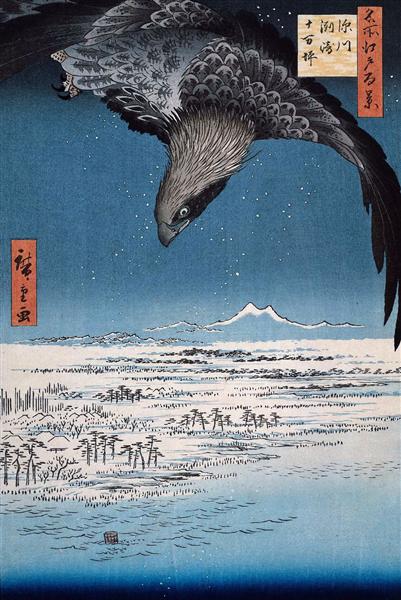Descriere
The 1857 work "Fukagawa Susaki and Jūmantsubo" by ukiyo-e master Utagawa Hiroshige stands out for its elegant depiction of the Japanese landscape and its ability to capture the essence of a particular moment in everyday life. In this composition, Hiroshige transports us to a landscape that displays his mastery of color, light and atmosphere, elements that place him as one of the greatest exponents of Japanese woodblock prints from the Edo period.
The work presents a panoramic view of the town of Fukagawa, where a vast plain stretches out under the dignified presence of a majestic eagle, an emblem of freedom and power. The figure of the eagle stands high above the vast expanses of land, its figure standing out not only for its size, but also for the way it interacts with its surroundings. The bird seems to attentively observe the landscape that unfolds below, a symbolic representation of vigilance and the incursive relationship between man and nature.
As for the colour palette used, Hiroshige applies a harmonious combination of hues ranging from the deep, golden greens of the vegetation to the soft blues of the sky. This palette not only suggests a specific time of day, possibly a sunset, but also evokes emotions of peace and contemplation. The brilliance of the green is contrasted with the serenity of the blue, creating a sense of balance that is characteristic of Hiroshige’s style. Each nuance serves a purpose, as it contributes to the overall atmosphere of the work, where an intrinsic tranquility is perceived amidst the vastness of the landscape.
The composition itself, centered on the plain, is enriched by the use of soft, undulating lines that guide the viewer’s gaze through the work, like a river flowing naturally through the countryside. This softness complements the strong figure of the eagle and brings a sense of continuity and connection with the surrounding space. Such an arrangement reflects not only technical mastery, but also a deep understanding of the relationship between elements in nature, which is a recurring theme in Hiroshige’s work.
As part of Hiroshige's oeuvre, "Fukagawa Susaki and Jūmantsubo" can also be contextualized within the ukiyo-e tradition, which seeks to capture the ephemeral beauty of life. The aesthetics of urban and rural landscapes reflect an inherent mortality in Japanese culture, and often highlight the importance of the natural environment in an individual's life. Hiroshige is widely known for his series of landscapes, such as "One Hundred Views of Edo," where he masterfully portrayed the seasonal variations and subtleties of everyday life in Japan.
To appreciate this painting is not only to enjoy its visual beauty, but also to enter into a dialogue with the cultural and spiritual context of its time. Throughout his career, Hiroshige developed an approach that fused the natural with the ethereal, inviting the viewer into an intimate experience with the landscape. Through “Fukagawa Susaki and Jūmantsubo,” not only an art that recalls the magnificence of existence is revealed, but also a profound homage to the relationship between humans and their environment, where each element, from the eagle to the plain, suggests a complexity full of meaning.
KUADROS ©, a famous painting on your wall.
Hand-made oil painting reproductions, with the quality of professional artists and the distinctive seal of KUADROS ©.
Painting reproduction service with satisfaction guarantee. If you are not completely satisfied with the replica of your painting, we will refund 100% of your money.

